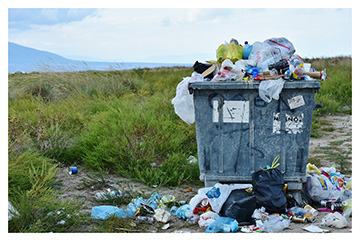Attainable, Sustainable Goals for the New Year
Committing to live a greener life in 2018 does not have to be a daunting task. A few small changes can make a big impact. Following are attainable, sustainable goals for the new year:
Ditch single-use items. Stop using single-use items like plastic water bottles and plastic sandwich bags. Invest in reusable water bottles, reusable bags, reusable napkins, reusable containers, reusable utensils and on and on..
Learn to recycle right. Recycling bin contamination continues to be a problem in America and China. However, China has had enough. Effective since September, China has banned the import of 24 varieties of solid waste, including types of plastic and unsorted paper commonly sent from the U.S. Municipalities are currently struggling, faced with overflowing recycling centers and are requesting they may be allowed to send recyclable paper and plastic to landfills. China’s current solution is to reduce versus recycle but if we learn to recycle better, maybe our recyclables will have more value in the future. How can you recycle correctly? Educate yourself. Every municipality is different but if you spend some time on your town’s public works web page or make a phone call to the office, you can find all the information you need to make sure your curbside recycling bin is not contaminated. For those who live in multi-unit dwellings, check with building management about recycling guidelines. Also, find out where you can recycle hard to recycle items like electronics and Styrofoam. It may require a little time and effort on your part, but you’ll feel better knowing these items won’t go to a landfill.
Reduce Food Waste. The United States Department of Agriculture says in the United States, food waste is estimated at between 30-40 percent of the food supply. Commit to using fresh produce and don’t let it spoil in your fridge. There are plenty of ways to use produce that is on the verge of going bad. If you don’t have the time, see if there’s a neighbor with a pet who will eat it. Additionally, don’t let leftovers go to waste. According to a recent article in the Washington Post, “American consumers throw away 27 million tons of food each year, according to the food waste coalition ReFED, clogging landfills, generating greenhouse gasses, and costing the economy an estimated $144 billion. The solution, however, could be simple: get people to eat leftovers again.”
Find a new home for old items. While you may not have a use for an item anymore, someone else might, event if the items are old and beat up. Consider old bath towels and pet beds. While a person might not want these used items, animal shelters will gladly accept them. There are so many ways to get rid of unwanted stuff and it’s easier than it’s ever been. Thrift stores like The Salvation Army and Goodwill are still viable options as are garage sales. However, if you want to get rid of stuff quickly, without ever leaving your home, use the Internet. There are all kinds of local Facebook groups where you can sell things at “online garage sales” or groups to giveaway free stuff. Craig’s List and Freecycle are two additional outlets to rehome your old stuff.
Reduce your carbon footprint: Use your car less. Bike or walk to nearby places and choose public transportation or carpooling for longer trips.
Learn to live with less. One doesn’t need to commit to a zero-waste lifestyle, but most people can live with less. Want inspiration? Read this interview with Bea Johnson, author of Zero Waste Home.
Volunteer. Commit to doing something good this year. Volunteer your time or donate money to an organization or cause important to you.



